Once upon a time, as long as 700,000 years ago, the Yukon was inhabited by turrrrrrrible beasts with hunched backs and long, pointed horns. They were the steppe bison, forefathers of our modern day wood bison. By 1900, however, the wood bison were nearly hunted to extinction. And there were none left in the Yukon.
With as few as 200-300 wood bison left, people finally recognized the need for conservation efforts and, in 1922, Wood Buffalo National Park was created. Things did not go well for the early conservation program, which was plagued by livestock disease and genetic contamination with plains bison. Fortunately, a healthy, un-contaminated was found in a remote area of the park and efforts were made to establish geographically separated herds of wood bison throughout different parts of Canada.
In 1980, Yukon decided to participate in the initiative and, between 1988 and 1922, 172 bison were set free. With only wolves as natural predators and restricted hunting by humans, the herd has grown at an estimated rate of up to 20% per year. (Information obtained from this source.)
The initiative has been so successful that the Department of the Environment realized that some form of population control would be required to keep the herds healthy. The department increased the number of bison tags available to Yukon hunters, eventually making tags available to anyone eligible from the Yukon with an interest in hunting a bison. They've even gone so far as to encourage hunters to hunt for female bison.
I decided it was time to try bison hunting.
Hunting was one of those things that, as a kid, I didn't support. Why kill something just for the "sport" of killing it? To my five-year-old self, that was just wrong. I still agree with my five-year-old-self in that respect, but I've also learned that the majority of hunters (the vast majority of those in the North, at least) are not hunting for trophies - they're hunting to feed themselves and their families. Done properly, hunting is a valuable part of ecosystem management. It can keep animal populations healthy. Also, I'm an omnivore. I enjoy eating meat and have no plans to give it up. Instead of being isolated from what it takes to provide that meat - not knowing what others are doing to the animals that provide my meat and having me and my family exposed to everything that gets into that animal - I decided it's time I picked up a new skill and begin supplying my family with a supply of healthy, sustainably-harvested meat from an animal that has lived a challenging, yet natural, life.
With the necessary tools and various skills at my disposal, my brother-in-law Mike and I set out to look for sign of a herd.
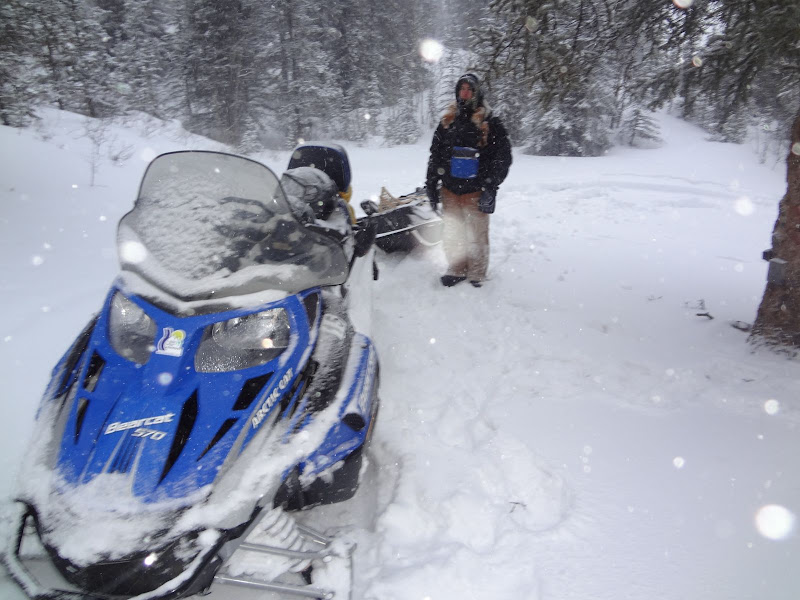
It was snowing pretty hard, which meant that we couldn't see very far, but at least we had the benefit of knowing that any tracks we found would be fresh. We scouted the trail, found the tracks of a lone bull bison, and continued on, looking for a herd with cows.
Bison live in two types of herds. The main type is a harem, where one bull is surrounded by a group of cows. Sometimes there will be some young bulls in the herd - until they're forced out on their own. Sometimes, the young bulls will group together to form a smaller herd. It's not an easy life for lone bison.
After scouting the area some more, we decided to return to the lone bull's tracks. They were quickly disappearing under the falling snow.
The bison walked in loop-de-loops, wandering in a seemingly nonsensical manner. We found where it had bedded down, got up, bedded down again, got up, and bedded down again. Loop-de-loop after loop-de-loop, stoping nowhere to feed or go to the bathroom. Eventually, it wandered down into a steep valley where there was no chance of retrieving the meat even if we managed to find it. The tracks had been fresh. On the way back to our snow machine, we saw that our snowshoe tracks had mostly disappeared in some spots.

The next day dawned clear and mostly-sunny and we decided to return to the area to look for fresh sign. We cut across some sign that looked like it might be two bison. We knew the tracks were fresh and had to have been made between late evening the night before and early morning, but it was hard to read much more that that; the wind was blowing strongly and the tracks were drifted over with snow.
I strapped on my snowshoes and followed the trail. They were making for high country where the sun was shining on the hillside.
I followed the tracks for about a kilometre before I found some tracks that hadn't been disturbed by the drifting snow. It was a cow and a calf moose; not what we were looking for.
On we went.

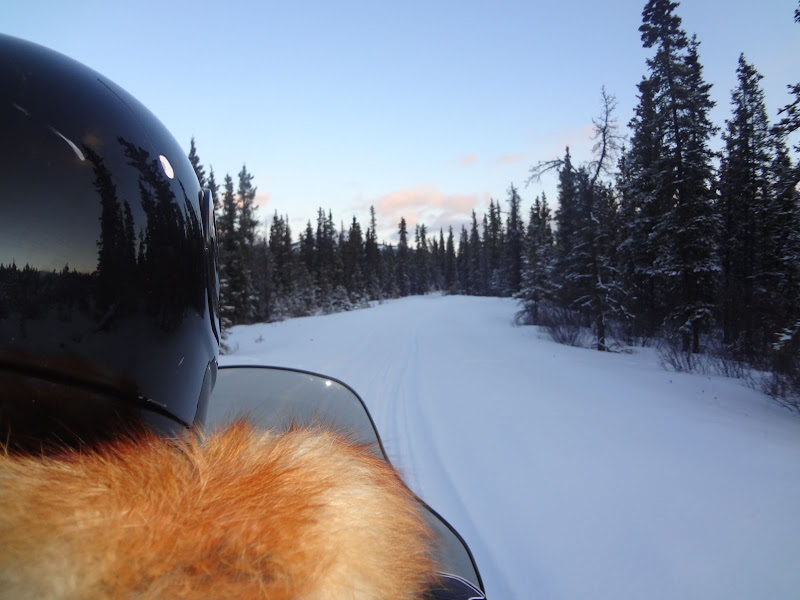
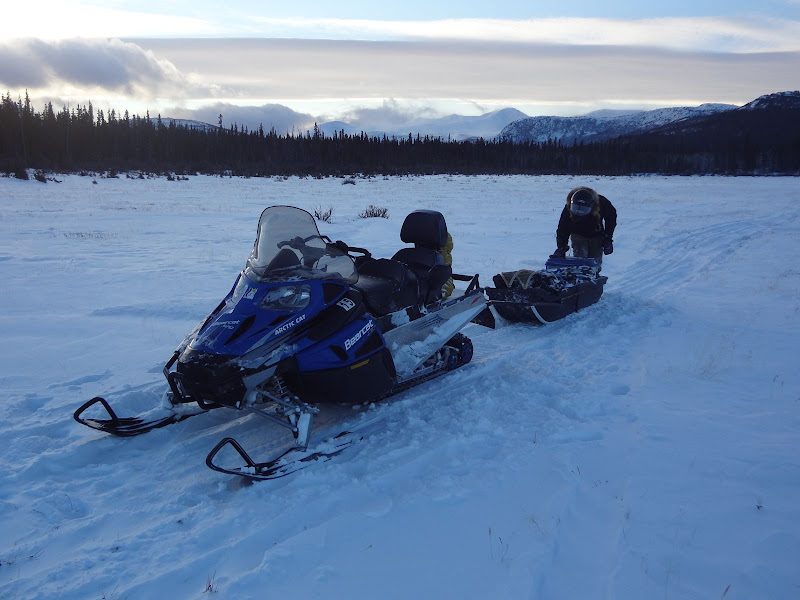
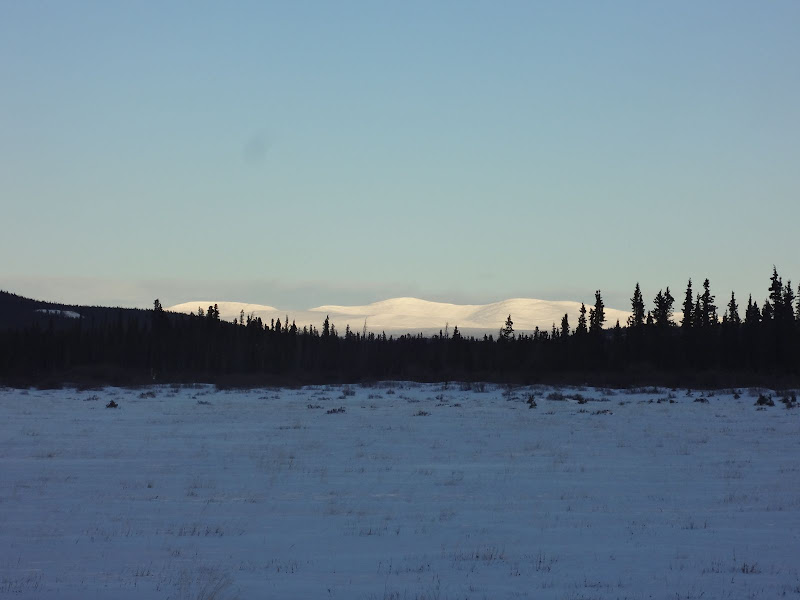
Following some other snow machine tracks, we came across a site where the bison had recently bedded down. There were other hunters in the area but none of them had followed the tracks. They were all bombing around on their snow machines. After a quick bite to eat, we strapped on our snowshoes and started tracking.
It took a little while to separate the fresh tracks from the fresher tracks, but we did it. The herd zig-zagged their way through the trees. I had no idea how far away they were until I found some fresh droppings. And then some more. And then some that was steaming fresh. And some urine. Bison, when they feel threatened, empty themselves out. I was close, but they were on guard.
And then I saw some movement. Less than fifty feet in front of me, a cow bison trotted across my path, stopping just off to my right. There was just one little problem. I had a clean shot, but it was only a clean shot of the back half of the cow. Small spruce trees obscured the front half of the cow. I needed a clear shot of the vital organs, so I planned to loop around in front of the cow and cut her off.
By the time I got there, she was already gone. Silently, she had trotted off through the trees. I followed her trail around as she tried to evade me through thick brush. She didn't make a sound. Eventually her trail looped back around, crossing our original trail. She had rejoined the herd.
I continued to track her. The scat was, literally, steaming fresh.
The trail came to a small lake and crossed it. I looked up in the sky. The sun was low. Reluctantly, because I knew I was close, it was time to end the hunt for the day.
Poor Mike, who was snowshoeing about ten minutes behind me (intentionally, to make sure we didn't make too much noise) never even got to see one of the bison.

The next day, we came back for a longer stay. Our plan was to spend a few nights in the area. That would give us more time for tracking, and more time if we actually got something. This time, my brother-and-law and I were joined by Christian.
Christian and a friend of his( who joined us for the day) went off in one direction and I resumed tracking the herd from the last known point.
Down a hill and across a chain of lakes, up a long, steep hill, and over the other side put us right back into prime bison country. They guys knew where they were going. Judging by the tracks, there appeared to be about six of them. We followed the tracks to a clearing where they had spent some time bedded down. It was always with relief that I saw the bedding sites; they meant that I would have less ground to cover to catch up to the herd.
Further down the valley, the tracks led to a larger lake. I slowly scoped out the lake, but didn't see any bison. I did see a large coyote, though.
The coyote stared at me and I stared at it. We were both curious about each other and lingered for a long time, sometimes pretending to ignore each other. And then the coyote took a dump and trotted along the ridge bordering the lake's north shore.

I continued tracking the herd around the lake's shoreline. I knew we were getting closer, but still had no idea how far away the herd might be. We came to a large, grassy meadow and I started getting excited. It was snowing gently out, but the tracks were fresh and it was apparent that the herd had spent a considerable amount of time grazing.
I picked up my pace and followed the trail up a slope and along the valley. Once again, I was impressed by how well these bison knew the area. They knew all the best routes.
Down into the valley again, I walked through a fairly open area. I slowed down to check out the area a little more slowly. Then I looked up and there she was.
Less than seventy-five feet away from me was a cow bison. She saw me and paid little attention.
Quickly, I shed the glove that was covering the barrel of my gun, took the protective covers off my scope, and loaded a bullet into the chamber. It only took a few seconds.
I took a step forward to rest the barrel of my gun on an old tree to ensure that I'd have the cleanest shot possible. And then a bull stepped forward, saw me, went "AAAAAAAAAAAAAAH!", spun around, and led the herd off into the trees at high speed. The bull had a large, yellow radio collar around its neck, so it has obviously had previous negative encounters with animals of the human persuasion.
I thought I knew which way they'd go, so I attempted to cut them off but, just like the cow the day before, they beat me to it. I charged ahead, hoping to gain on them in my snowshoes. For another forty minutes I charged on as they made for the high ground. Eventually, I stopped and checked the time. It was time to head back. Darkness would be arriving soon and we still had to make camp.
Skunked again!
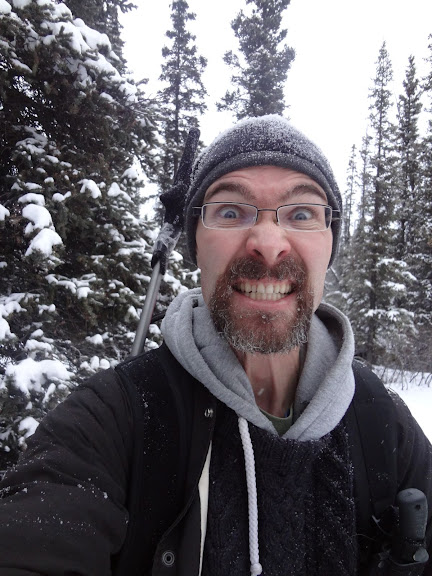
And poor, poor Mike was so disappointed that he didn't get to see the bison.

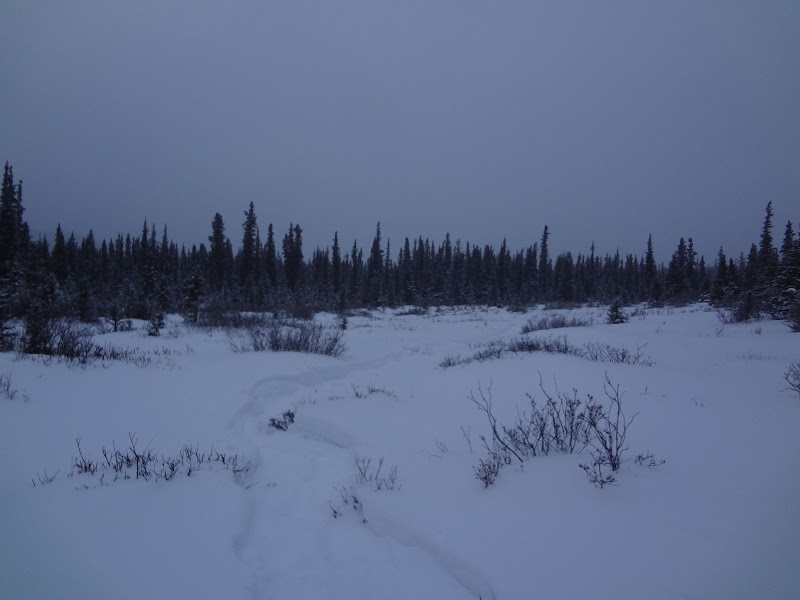
It was Mike's first time winter camping. I explained that the act of camping in the winter is seldom enjoyable while you're doing it - it's when you get home that you appreciate how great winter camping is, because it makes you appreciate what you've got at home.
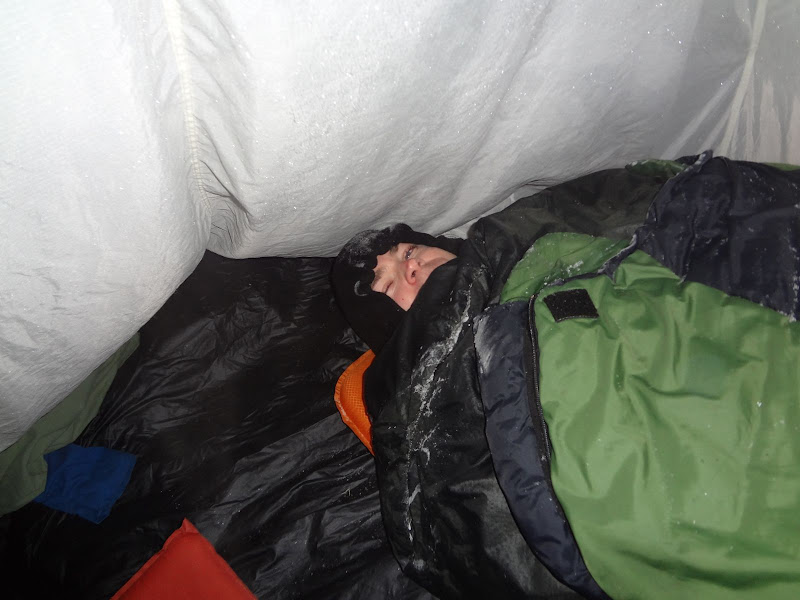
Oh, and I hate winter camping in a tent. I'd rather sleep in the open air or a snow hut where the moisture doesn't accumulate and it's easier to stay warm. If you want to build your own snow hut, you can learn how to do it here.
Christian was up early the next day. He was going to take a turn picking up the bison trail where I had left it. Mike and I had a new mission. If we got a bison, we'd need a way to get the meat out - and we would do that with the snow machine and skimmer (toboggan), but the trail that we packed the day before went over a hill that was too steep for a snow machine. Mike and I set out to find a more accessible route into the area.
We followed the chain of lakes in both directions, being careful to avoid the dangerous inflow and outflow areas where open water hid treacherously under the ice.
We made our way into prime bison habitat, a large open meadow full of grasses. Judging by the old, frozen bison droppings, they like to spend a lot of time there - but that's not where they were that day.

The openness of the area gave us incredible panoramic views of the mountains. There is some incredible alpine walking up there.

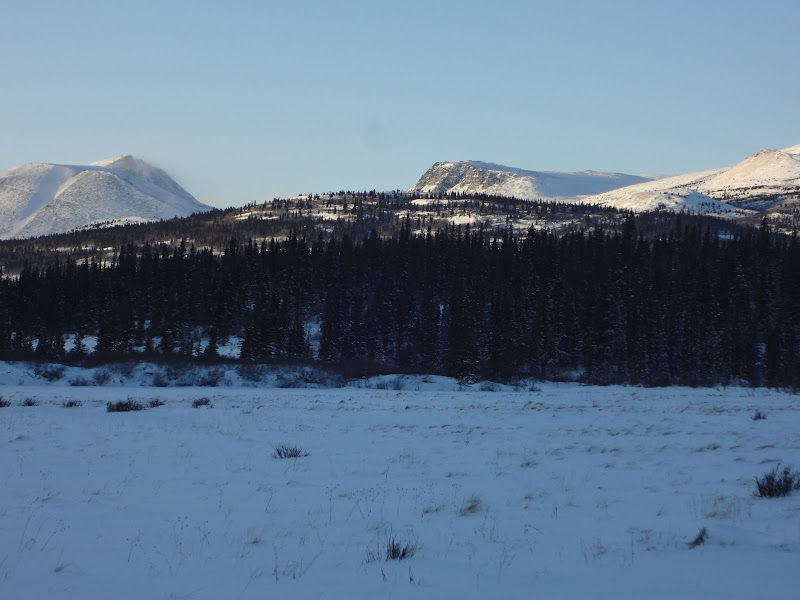
There was a crook in the meadow where it looked like we might be able to get a snow machine around the hill to the lake where I last saw the bison. Sure enough, there were old, drifted-over bison tracks. We followed the tracks up to and along a moraine that led right to the lake where I saw them last.
Those bison, I tell ya, they know that area like the back of their hoof.
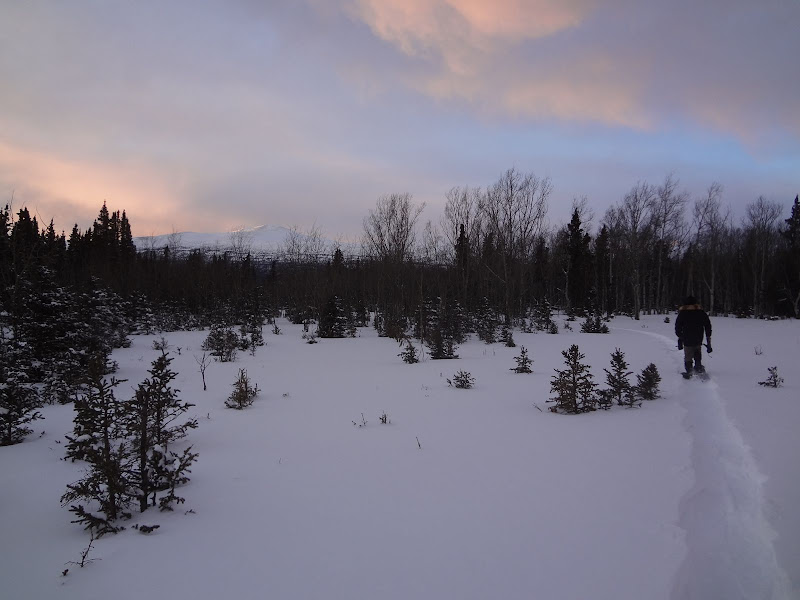
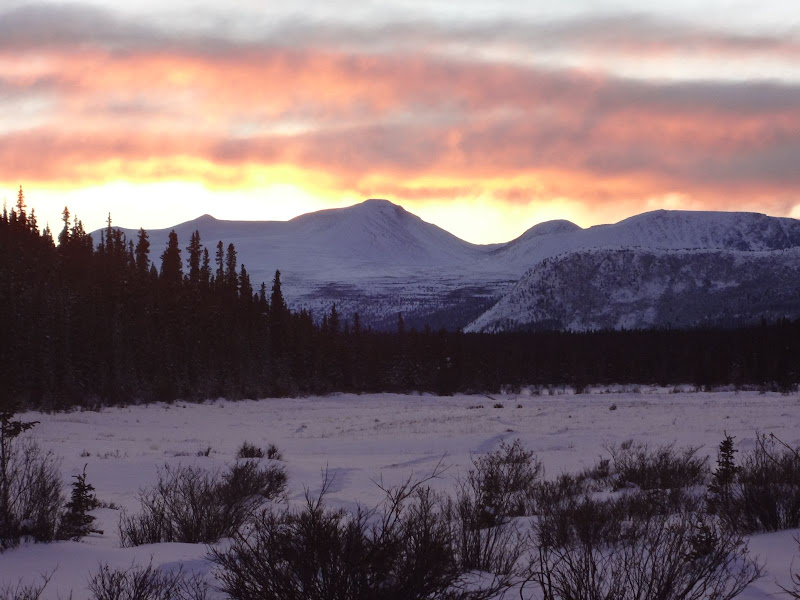
We caught up to Christian, but he hadn't had any luck. The short winter days really didn't give us a lot of time for tracking before we had to make our way back to camp.


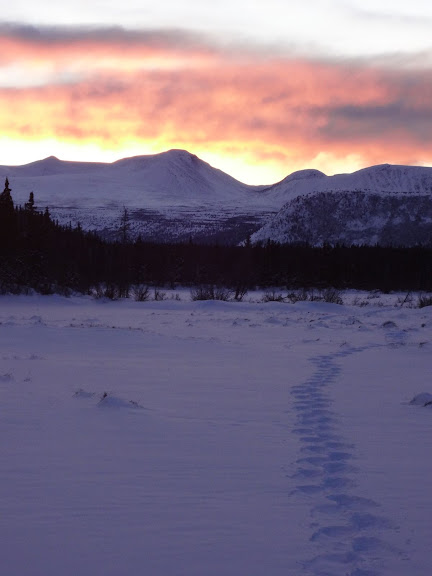
Once again, we cooked supper over the fire in the dark. The sky was clear and Christian and I both predicted that cold was coming. We huddled around the fire before turning in for an early night.


We were right about the temperature dropping.
It was a cold night in the tent (and did I mention how much I dislike sleeping in a tent in the winter?), but we didn't get up until around 10:00 the next morning.
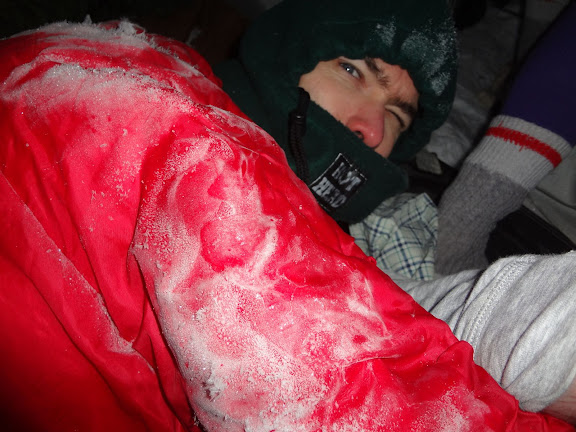
It was cold enough that our fingers were sticking to anything made of metal. A cheap, little thermometer that I keep on my day pack indicated that it was somewhere below -25oC. How much further below -25oC we don't know. The thermometer doesn't measure lower than that.

We decided that our hunt had come to an end. Even if we managed to get a bison, it would be unpleasantly cold to field dress and we were running out of time before the end of the bison hunting season. We packed camp, got our snow machines running, and headed for the truck and trailer.
I was pleasantly surprised when the truck started running, though it groaned in protest.
At home, we unpacked our gear and the leftover food supplies. I've never seen olive oil "freeze" before.
Apparently, it happens around -38oC.
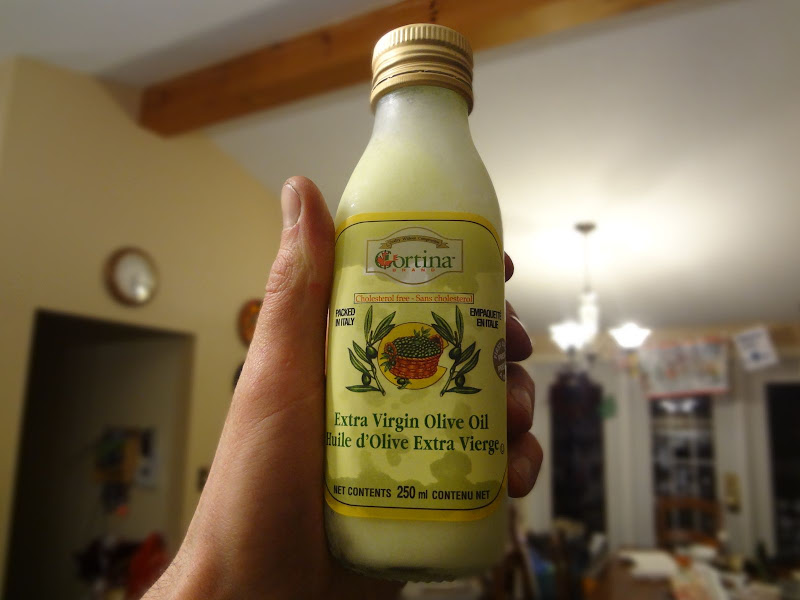
So we didn't get a bison. I did not provide for my family like I'd hoped. Instead of bringing home thousands of dollars worth of meat, I spent a bunch of money on fuel and a snow machine rental.
But that's OK.
I learned a lot, I think Mike enjoyed himself, and I'm that much closer to success for the next time.
No bull.
With as few as 200-300 wood bison left, people finally recognized the need for conservation efforts and, in 1922, Wood Buffalo National Park was created. Things did not go well for the early conservation program, which was plagued by livestock disease and genetic contamination with plains bison. Fortunately, a healthy, un-contaminated was found in a remote area of the park and efforts were made to establish geographically separated herds of wood bison throughout different parts of Canada.
In 1980, Yukon decided to participate in the initiative and, between 1988 and 1922, 172 bison were set free. With only wolves as natural predators and restricted hunting by humans, the herd has grown at an estimated rate of up to 20% per year. (Information obtained from this source.)
The initiative has been so successful that the Department of the Environment realized that some form of population control would be required to keep the herds healthy. The department increased the number of bison tags available to Yukon hunters, eventually making tags available to anyone eligible from the Yukon with an interest in hunting a bison. They've even gone so far as to encourage hunters to hunt for female bison.
I decided it was time to try bison hunting.
Hunting was one of those things that, as a kid, I didn't support. Why kill something just for the "sport" of killing it? To my five-year-old self, that was just wrong. I still agree with my five-year-old-self in that respect, but I've also learned that the majority of hunters (the vast majority of those in the North, at least) are not hunting for trophies - they're hunting to feed themselves and their families. Done properly, hunting is a valuable part of ecosystem management. It can keep animal populations healthy. Also, I'm an omnivore. I enjoy eating meat and have no plans to give it up. Instead of being isolated from what it takes to provide that meat - not knowing what others are doing to the animals that provide my meat and having me and my family exposed to everything that gets into that animal - I decided it's time I picked up a new skill and begin supplying my family with a supply of healthy, sustainably-harvested meat from an animal that has lived a challenging, yet natural, life.
With the necessary tools and various skills at my disposal, my brother-in-law Mike and I set out to look for sign of a herd.
It was snowing pretty hard, which meant that we couldn't see very far, but at least we had the benefit of knowing that any tracks we found would be fresh. We scouted the trail, found the tracks of a lone bull bison, and continued on, looking for a herd with cows.
Bison live in two types of herds. The main type is a harem, where one bull is surrounded by a group of cows. Sometimes there will be some young bulls in the herd - until they're forced out on their own. Sometimes, the young bulls will group together to form a smaller herd. It's not an easy life for lone bison.
After scouting the area some more, we decided to return to the lone bull's tracks. They were quickly disappearing under the falling snow.
The bison walked in loop-de-loops, wandering in a seemingly nonsensical manner. We found where it had bedded down, got up, bedded down again, got up, and bedded down again. Loop-de-loop after loop-de-loop, stoping nowhere to feed or go to the bathroom. Eventually, it wandered down into a steep valley where there was no chance of retrieving the meat even if we managed to find it. The tracks had been fresh. On the way back to our snow machine, we saw that our snowshoe tracks had mostly disappeared in some spots.
The next day dawned clear and mostly-sunny and we decided to return to the area to look for fresh sign. We cut across some sign that looked like it might be two bison. We knew the tracks were fresh and had to have been made between late evening the night before and early morning, but it was hard to read much more that that; the wind was blowing strongly and the tracks were drifted over with snow.
I strapped on my snowshoes and followed the trail. They were making for high country where the sun was shining on the hillside.
I followed the tracks for about a kilometre before I found some tracks that hadn't been disturbed by the drifting snow. It was a cow and a calf moose; not what we were looking for.
On we went.
Following some other snow machine tracks, we came across a site where the bison had recently bedded down. There were other hunters in the area but none of them had followed the tracks. They were all bombing around on their snow machines. After a quick bite to eat, we strapped on our snowshoes and started tracking.
It took a little while to separate the fresh tracks from the fresher tracks, but we did it. The herd zig-zagged their way through the trees. I had no idea how far away they were until I found some fresh droppings. And then some more. And then some that was steaming fresh. And some urine. Bison, when they feel threatened, empty themselves out. I was close, but they were on guard.
And then I saw some movement. Less than fifty feet in front of me, a cow bison trotted across my path, stopping just off to my right. There was just one little problem. I had a clean shot, but it was only a clean shot of the back half of the cow. Small spruce trees obscured the front half of the cow. I needed a clear shot of the vital organs, so I planned to loop around in front of the cow and cut her off.
By the time I got there, she was already gone. Silently, she had trotted off through the trees. I followed her trail around as she tried to evade me through thick brush. She didn't make a sound. Eventually her trail looped back around, crossing our original trail. She had rejoined the herd.
I continued to track her. The scat was, literally, steaming fresh.
The trail came to a small lake and crossed it. I looked up in the sky. The sun was low. Reluctantly, because I knew I was close, it was time to end the hunt for the day.
Poor Mike, who was snowshoeing about ten minutes behind me (intentionally, to make sure we didn't make too much noise) never even got to see one of the bison.
The next day, we came back for a longer stay. Our plan was to spend a few nights in the area. That would give us more time for tracking, and more time if we actually got something. This time, my brother-and-law and I were joined by Christian.
Christian and a friend of his( who joined us for the day) went off in one direction and I resumed tracking the herd from the last known point.
Down a hill and across a chain of lakes, up a long, steep hill, and over the other side put us right back into prime bison country. They guys knew where they were going. Judging by the tracks, there appeared to be about six of them. We followed the tracks to a clearing where they had spent some time bedded down. It was always with relief that I saw the bedding sites; they meant that I would have less ground to cover to catch up to the herd.
Further down the valley, the tracks led to a larger lake. I slowly scoped out the lake, but didn't see any bison. I did see a large coyote, though.
The coyote stared at me and I stared at it. We were both curious about each other and lingered for a long time, sometimes pretending to ignore each other. And then the coyote took a dump and trotted along the ridge bordering the lake's north shore.
I continued tracking the herd around the lake's shoreline. I knew we were getting closer, but still had no idea how far away the herd might be. We came to a large, grassy meadow and I started getting excited. It was snowing gently out, but the tracks were fresh and it was apparent that the herd had spent a considerable amount of time grazing.
I picked up my pace and followed the trail up a slope and along the valley. Once again, I was impressed by how well these bison knew the area. They knew all the best routes.
Down into the valley again, I walked through a fairly open area. I slowed down to check out the area a little more slowly. Then I looked up and there she was.
Less than seventy-five feet away from me was a cow bison. She saw me and paid little attention.
Quickly, I shed the glove that was covering the barrel of my gun, took the protective covers off my scope, and loaded a bullet into the chamber. It only took a few seconds.
I took a step forward to rest the barrel of my gun on an old tree to ensure that I'd have the cleanest shot possible. And then a bull stepped forward, saw me, went "AAAAAAAAAAAAAAH!", spun around, and led the herd off into the trees at high speed. The bull had a large, yellow radio collar around its neck, so it has obviously had previous negative encounters with animals of the human persuasion.
I thought I knew which way they'd go, so I attempted to cut them off but, just like the cow the day before, they beat me to it. I charged ahead, hoping to gain on them in my snowshoes. For another forty minutes I charged on as they made for the high ground. Eventually, I stopped and checked the time. It was time to head back. Darkness would be arriving soon and we still had to make camp.
Skunked again!
"Aww! I missed them again?!"
Back we went to make camp.
It was Mike's first time winter camping. I explained that the act of camping in the winter is seldom enjoyable while you're doing it - it's when you get home that you appreciate how great winter camping is, because it makes you appreciate what you've got at home.
Oh, and I hate winter camping in a tent. I'd rather sleep in the open air or a snow hut where the moisture doesn't accumulate and it's easier to stay warm. If you want to build your own snow hut, you can learn how to do it here.
Christian was up early the next day. He was going to take a turn picking up the bison trail where I had left it. Mike and I had a new mission. If we got a bison, we'd need a way to get the meat out - and we would do that with the snow machine and skimmer (toboggan), but the trail that we packed the day before went over a hill that was too steep for a snow machine. Mike and I set out to find a more accessible route into the area.
We followed the chain of lakes in both directions, being careful to avoid the dangerous inflow and outflow areas where open water hid treacherously under the ice.
We made our way into prime bison habitat, a large open meadow full of grasses. Judging by the old, frozen bison droppings, they like to spend a lot of time there - but that's not where they were that day.

The openness of the area gave us incredible panoramic views of the mountains. There is some incredible alpine walking up there.
There was a crook in the meadow where it looked like we might be able to get a snow machine around the hill to the lake where I last saw the bison. Sure enough, there were old, drifted-over bison tracks. We followed the tracks up to and along a moraine that led right to the lake where I saw them last.
Those bison, I tell ya, they know that area like the back of their hoof.
We caught up to Christian, but he hadn't had any luck. The short winter days really didn't give us a lot of time for tracking before we had to make our way back to camp.
Once again, we cooked supper over the fire in the dark. The sky was clear and Christian and I both predicted that cold was coming. We huddled around the fire before turning in for an early night.
We were right about the temperature dropping.
It was a cold night in the tent (and did I mention how much I dislike sleeping in a tent in the winter?), but we didn't get up until around 10:00 the next morning.
It was cold enough that our fingers were sticking to anything made of metal. A cheap, little thermometer that I keep on my day pack indicated that it was somewhere below -25oC. How much further below -25oC we don't know. The thermometer doesn't measure lower than that.
We decided that our hunt had come to an end. Even if we managed to get a bison, it would be unpleasantly cold to field dress and we were running out of time before the end of the bison hunting season. We packed camp, got our snow machines running, and headed for the truck and trailer.
I was pleasantly surprised when the truck started running, though it groaned in protest.
At home, we unpacked our gear and the leftover food supplies. I've never seen olive oil "freeze" before.
Apparently, it happens around -38oC.
So we didn't get a bison. I did not provide for my family like I'd hoped. Instead of bringing home thousands of dollars worth of meat, I spent a bunch of money on fuel and a snow machine rental.
But that's OK.
I learned a lot, I think Mike enjoyed himself, and I'm that much closer to success for the next time.
No bull.
No comments:
Post a Comment